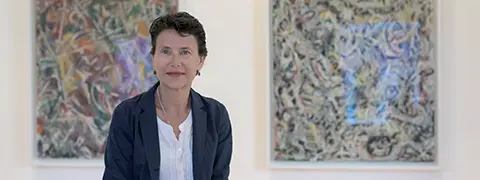
A cutting-edge microscope for restoring artworks
Mapei is continuing its partnership with the Peggy Guggenheim Collection helping develop technology for conservation purposes.
Mapei is continuing its partnership with the Peggy Guggenheim Collection helping develop technology for conservation purposes.
Mapei first encountered the Peggy Guggenheim Collection in 2009 when, driven by the firm belief that “work cannot be separated from art” (as its founder, Rodolfo Squinzi, used to say), it decided to join the museum’s Corporate Membership project called ‘Guggenheim Intrapresæ’. Every year Mapei takes an active part in the Collection’s life with the same efficiency, flexibility and durability characterising the materials it manufactures worldwide, supporting the Collection’s gradual process of change and development. This was exemplified in 2009 by the renovation of Palazzo Venier dei Leoni hosting the Collection and also by its involvement in the Capital Campaign (2014-2016) aimed at acquiring and converting spaces that now host temporary exhibitions, the Venetian museum’s first room offering children and families free educational activities, and a new coffee bar (see Realtà Mapei International no. 31, 60, and 62).
In 2019 Mapei is helping purchase a latest-generation optical microscope to help the institution’s conservation laboratory restore important works of art. This provided an invaluable contribution to the process of technological advancement in the realm of conservation that the Peggy Guggenheim Collection began a few years ago. This vital instrument will allow the museum laboratory to carry out work internally and help the museum compete with other important international enterprises in the field of conserving modern and contemporary works of art, such as the Tate Museums in London and Opificio delle Pietre Dure in Florence.
An optical microscope is a non-invasive high-precision diagnostic tool for studying surfaces to analyse a painting’s construction, any layers that may have been added on at a later date, and its state of conservation. Thanks to its extremely high magnifying power, this instrument is extremely useful for studying pictorial techniques and painting textures and is vital for the analytic study of 20th-century works that are composed of various materials applied to canvases using innovative pictorial techniques.
This binocular microscope will be used for the first time on a set of four works by Edmondo Bacci, a Venetian artist who drew on the physicality of Action Painting and mixed oil colours with sand to form ripples. This technique is particularly evident in Avvenimento #247, the first of his works planned to be restored with the aid of the new microscope. Avvenimento #247 will be on display in an exhibition entitled Peggy Guggenheim. L’ultima Dogaressa (Peggy Guggenheim. The Last Dogaressa) which will open on 21st
September 2019, alongside works by other Italian artists from the 1940s, such as Tancredi Parmeggiani and Emilio Vedova. The exhibition will be a tribute to Peggy Guggenheim’s post-1948 collections, the year when the “dogaressa” moved to Venice: paintings, sculptures and paper works acquired between the end of the 1940s and 1979. This will be the crowning moment in an entire year aimed at commemorating two crucial dates that left their mark not only on the Collection’s own history but on the history of 20th-century art as a whole: 1949, the year when Peggy bought Palazzo Venier dei Leoni where she then hosted her first exhibition of contemporary sculpture, opening its doors to the general public, and 1979, the year when she passed away.





.jpg?sfvrsn=1fc9987a_6)


